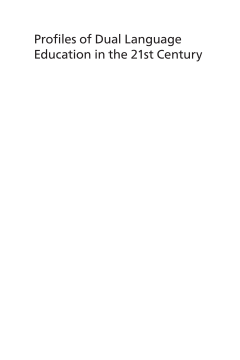
BOOK
Profiles of Dual Language Education in the 21st Century
Prof. M. Beatriz Arias | Molly Fee
(2018)
Additional Information
Book Details
Abstract
In the last 20 years dual language education programs have increased in number and expanded in range. Whereas once they were predominantly focused at the elementary level, they now span from pre-K through to high school. This book examines the key attributes of successful dual language programs, as well as the challenges and opportunities involved in extending the dual language instructional model to pre-K and secondary settings. Chapter authors, who are themselves both researchers and practitioners, explore the latest research and policy implications for implementation of dual language in three different contexts; within a school, a dual language school and a dual language district. This book will be of interest to teachers, teacher educators, professional development specialists, policymakers, administrators, and researchers.
M. Beatriz Arias is a Senior Research Scientist at the Center for Applied Linguistics, Washington, DC. Her scholarly interests center on educational language policy and programs for emergent bilinguals/English language learners.
Molly Fee is a PhD student in the Department of Sociology at UCLA. Her research interests focus on refugee resettlement, international migration, political sociology, and language policy.
Until now, very little attention has been devoted to the processes within programs that deliver dual language instruction. Aligned with new scientific foundations indicating the positive merits related to dual language learning, this timely volume provides the bridge to the new realities of providing the most positive schooling experience at the most critical time for DLLs/ELLs.
This book is a solid ‘best practice share’ from some of our most committed colleagues in the field. An essential and relevant resource that provides insight into how we can meet the challenges of program implementation and sustainability. Whether launching or strengthening your program, it is a must-read for our dual language community.
Table of Contents
| Section Title | Page | Action | Price |
|---|---|---|---|
| DOI https://doi.org/10.21832/ARIAS1664 | iv | ||
| Contents | v | ||
| Contributors | vii | ||
| Preface | xiii | ||
| Foreword: The Re-emergence of Bilingual Education as Dual Language Education | xix | ||
| Part 1 Dual Language Programs | 1 | ||
| 1 Recent Research on the Three Goals of Dual Language Education | 3 | ||
| 2 Legacy Programs: Key Elementary, Arlington, Virginia | 20 | ||
| 3 Dual Language Bilingual Education in NYC: A Potential Unfulfilled? | 38 | ||
| 4 Elgin, Illinois: An Entire District Goes Dual. The Journey of a District Committed to Culturally and Linguistically Responsive Instruction | 56 | ||
| Part 2 Implementing Dual Language: Programmatic Issues | 71 | ||
| 5 Implications of Research for Dual Language at the Early Childhood Level | 73 | ||
| 6 Opportunities and Dilemmas for TWI Programs at the Secondary Level | 86 | ||
| 7 Teacher Preparation for Dual Language Classrooms | 103 | ||
| 8 Making Space for Dual Language Education: The Role of Policy | 115 | ||
| Conclusion: Taking Stock: Lessons on Dual Language Education | 133 | ||
| Index | 156 |
